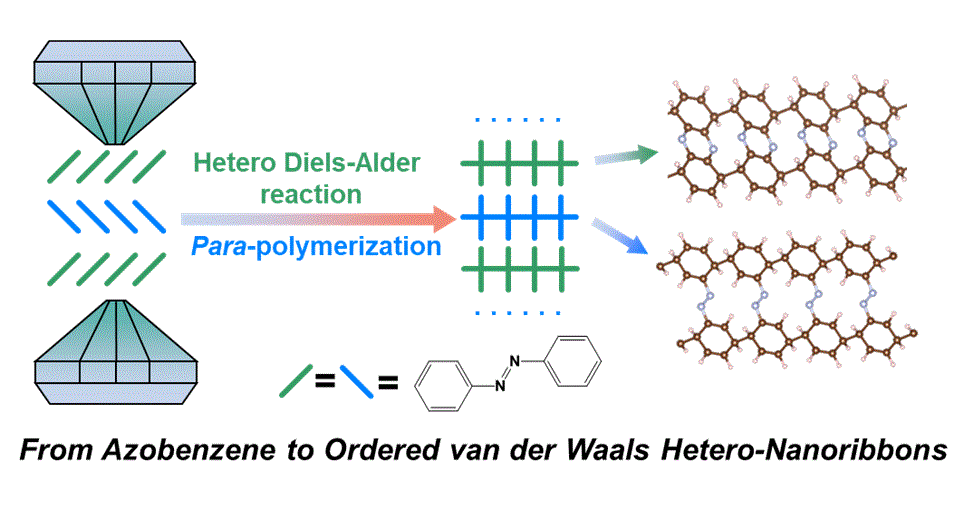
New work from a team of scientists led by Drs. Haiyan Zheng and Kuo Li from the Center for High Pressure Science and Technology Advanced Research (HPSTAR) synthesized ordered van der Waals hetero-nanoribbons via pressure-induced topochemical polymerization of azobenzene. The result is published recently in the Journal of the American Chemical Society.
Van der Waals (vdW) heterostructure is constructed by two or more materials with distinct chemical compositions, structures or properties. This approach of non-destructively integrating materials, which avoids the drawbacks of lattice matching and processing technologies, has drawn significant interest from researchers in the domains of fundamental physics, chemistry, and materials science. VdW heterostructures are now mainly made by physical transfer, chemical vapor deposition, and self-assembly, however it is still difficult to synthesize bulk atomic-scale ordered heterostructure materials.
Since topochemical polymerization using lattices as templates often starts at the nearest unsaturated atoms between neighbor molecules, the single-component crystals with various molecular stacking hold the promise for designed synthesis of atomic-scale ordered vdW heterostructures from the bottom up. The team demonstrated the pressure-induced topochemical polymerization of azobenzene, which has a crystal with two kinds of molecular stacking (A layer and B layer), and found [4+2] hetero-Diels-Alder (HDA) reactions of phenylazo-phenyl in layer A and para-polymerization of phenyl in layer B above 18 GPa. Different reaction selectivity make the single-component azobenzene transform into an ordered vdW heterostructure composing two kinds of carbon-nitrogen nanoribbons. The energy band structure of this vdW heterostructure has a clear relationship with the highest occupied /the lowest unoccupied occupied molecular orbital of these two kinds of carbon-nitrogen nanoribbons, which demonstrates the great advantage of ordered vdW heterostructure in energy band structure tuning.
This is the first example to produce the vdW heterostructure by using the pressure-induced topochemical polymerization of monomers with different stackings, which provides a novel and fresh perspective on the creation of bulk heterostructure materials.

范德华异质结是由两种或两种以上具有不同化学成分、结构或性质的材料通过弱范德华力排列而成的异质结构,因其独特的性质和在高性能光电子和能量存储器件中的潜在应用而受到广泛关注。目前,范德华异质结的制备方式主要包括物理转移、化学气相沉积及自组装等。然而,原子尺度有序范德华异质结的精准合成仍然是一个亟待解决的难题,这限制了范德华异质结进一步的实际应用。近日,北京高压科学研究中心的李阔、郑海燕课题组通过偶氮苯分子晶体的高压拓扑聚合反应首次合成了有序的范德华碳氮纳米带异质结。相关结果日前发表于《美国化学会志》。